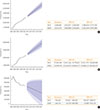1. International Diabetes Federation. IDF diabetes atlas. 6th ed. Brussels: International Diabetes Federation;2013.
2. Song SO, Jung CH, Song YD, Park CY, Kwon HS, Cha BS, et al. Background and data configuration process of a nationwide population-based study using the Korean National Health Insurance System. Diabetes Metab J. 2014; 38:395–403.
3. O'Shea M, Teeling M, Bennett K. The prevalence and ingredient cost of chronic comorbidity in the Irish elderly population with medication treated type 2 diabetes: a retrospective cross-sectional study using a national pharmacy claims database. BMC Health Serv Res. 2013; 13:23.
4. Kim DJ. The epidemiology of diabetes in Korea. Diabetes Metab J. 2011; 35:303–308.
5. Shin CS, Lee HK, Koh CS, Kim YI, Shin YS, Yoo KY, et al. Risk factors for the development of NIDDM in Yonchon County, Korea. Diabetes Care. 1997; 20:1842–1846.
6. Cho NH. The epidemiology of diabetes in Korea: from the economics to genetics. Korean Diabetes J. 2010; 34:10–15.
7. Oh JY, Lee HJ, Hong ES, Hong YS, Sung YA, Lee SH. The prevalence and incidence of diabetes in Mokdong, Seoul. J Korean Diabetes Assoc. 2003; 27:73–83.
8. Song KH, Nam-Goomg IS, Han SM, Kim MS, Lee EJ, Lee YS, et al. Change in prevalence and 6-year incidence of diabetes and impaired fasting glucose in Korean subjects living in a rural area. Diabetes Res Clin Pract. 2007; 78:378–384.
9. Task Force Team for Basic Statistical Study of Korean Diabetes Mellitus from the Korean Diabetes Association. Diabetes fact sheet in Korea 2013 [Internet]. Seoul: Korean Diabetes Association;2013. cited 2016 May 11. Available from:
http://www.diabetes.or.kr/.
10. Task Force Team for Basic Statistical Study of Korean Diabetes Mellitus from the Korean Diabetes Association. Diabetes fact sheet in Korea 2015 [Internet]. Seoul: Korean Diabetes Association;2015. cited 2016 May 11. Available from:
http://www.diabetes.or.kr/.
11. Koo BK, Lee CH, Yang BR, Hwang SS, Choi NK. The incidence and prevalence of diabetes mellitus and related atherosclerotic complications in Korea: a National Health Insurance Database Study. PLoS One. 2014; 9:e110650.
12. Jeon JY, Ko SH, Kwon HS, Kim NH, Kim JH, Kim CS, et al. Prevalence of diabetes and prediabetes according to fasting plasma glucose and HbA1c. Diabetes Metab J. 2013; 37:349–357.
13. Lee YH, Bang H, Kim HC, Kim HM, Park SW, Kim DJ. A simple screening score for diabetes for the Korean population: development, validation, and comparison with other scores. Diabetes Care. 2012; 35:1723–1730.
14. Task Force Team for Basic Statistical Study of Korean Diabetes Mellitus of Korean Diabetes Association. Park IB, Kim J, Kim DJ, Chung CH, Oh JY, et al. Diabetes epidemics in Korea: reappraise nationwide survey of diabetes "diabetes in Korea 2007". Diabetes Metab J. 2013; 37:233–239.
15. Cho NH. Diabetes burden and prevention in Korea and the Western Pacific Region. Diabetes Res Clin Pract. 2014; 106:Suppl 2. S282–S287.
16. Jansson SP, Fall K, Brus O, Magnuson A, Wandell P, Ostgren CJ, et al. Prevalence and incidence of diabetes mellitus: a nationwide population-based pharmaco-epidemiological study in Sweden. Diabet Med. 2015; 32:1319–1328.
17. Kim CS, Ko SH, Kwon HS, Kim NH, Kim JH, Lim S, et al. Prevalence, awareness, and management of obesity in Korea: data from the Korea National Health and Nutrition Examination Survey (1998-2011). Diabetes Metab J. 2014; 38:35–43.
18. Lee CH, Sung NY, Lee J, Bae SC. Factors associated with gout in South Koreans: analysis using the National Health Insurance Corporation and the National Health Screening Exam databases. Clin Rheumatol. 2013; 32:829–837.









 PDF
PDF ePub
ePub Citation
Citation Print
Print



 XML Download
XML Download